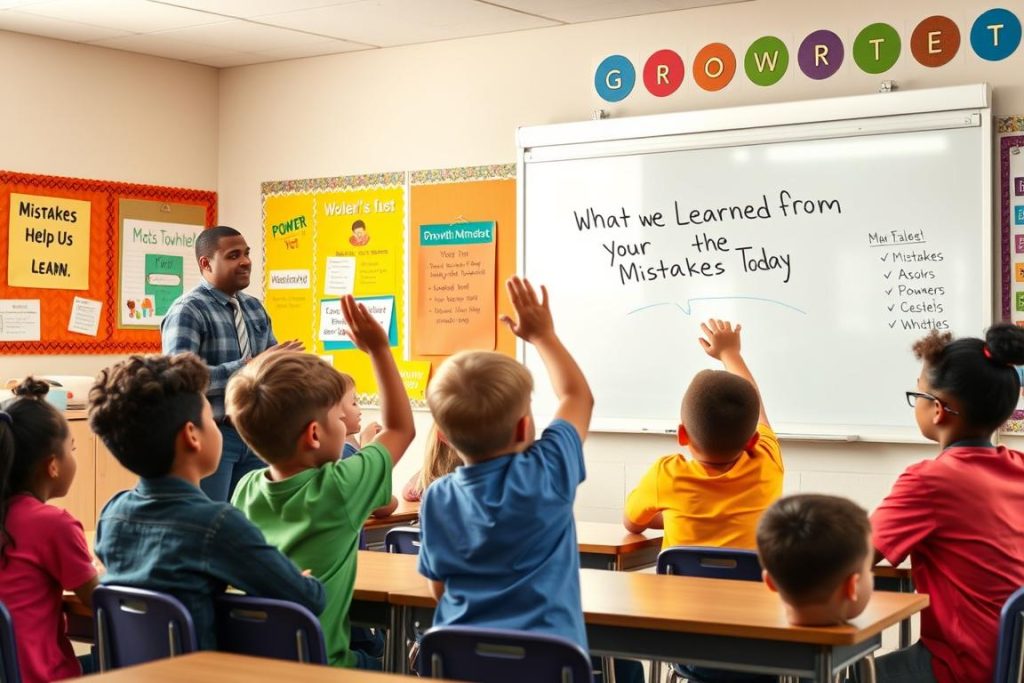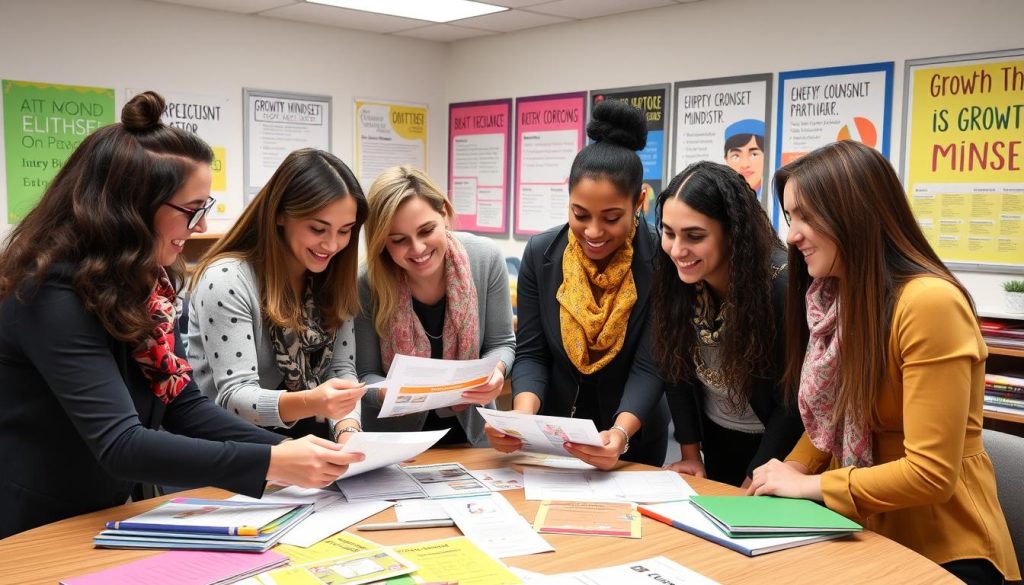Implementing Growth Mindset principles can transform classroom dynamics and student achievement
What is Growth Mindset and Why It Matters for Teacher Skills
Growth Mindset, a concept pioneered by Stanford psychologist Carol Dweck, is the belief that abilities and intelligence can be developed through dedication, hard work, and effective learning strategies. This contrasts with a fixed mindset, which assumes that our basic qualities, like intelligence or talent, are static traits that cannot be significantly changed.
For K12 teachers, understanding Growth Mindset isn’t just another educational theory—it’s a fundamental teacher skill that can dramatically impact student outcomes. Professional development in this area equips educators with the tools to nurture resilience and learning persistence in their students.
Growth Mindset Characteristics
- Embraces challenges as opportunities
- Persists in the face of setbacks
- Sees effort as a path to mastery
- Learns from criticism and feedback
- Finds inspiration in others’ success
- Views mistakes as valuable learning experiences
Fixed Mindset Characteristics
- Avoids challenges to prevent failure
- Gives up easily when facing obstacles
- Views effort as fruitless or unnecessary
- Ignores useful negative feedback
- Feels threatened by others’ success
- Hides flaws instead of addressing them
According to research from Mindset Works, students with a Growth Mindset show greater motivation in school, better grades, and higher test scores. When teacher skills include fostering this mindset, students become more engaged learners who view challenges as opportunities rather than threats.
The Science Behind Growth Mindset: What Teachers Need to Know
The concept of Growth Mindset isn’t just motivational—it’s grounded in neuroscience. Understanding the brain science behind this approach enhances teacher skills and provides a compelling framework to share with students.
When we learn something new, our brains form neural connections. With practice and repetition, these connections strengthen, making the skill or knowledge more accessible. This process, called neuroplasticity, continues throughout our lives—our brains are constantly capable of growth and change.
Neuroplasticity allows our brains to form new connections throughout life—the biological basis of Growth Mindset
Effective teacher skills include explaining this concept to students in age-appropriate ways. When students understand that their brains physically change and grow stronger with effort—like muscles during exercise—they’re more likely to persist through challenges.
“The brain is like a muscle. When we use it, it becomes stronger. When we learn new things, our brain forms new connections that make us smarter over time.”
— Simplified explanation for elementary students
A 2019 study published in Nature found that even brief interventions teaching students about neuroplasticity can lead to improved academic performance. This research reinforces how crucial it is for teacher skills to include communicating brain science concepts effectively.
By incorporating these scientific insights into your teaching approach, you create a classroom environment where students understand the biological basis for their capacity to grow and improve with effort.
Practical Growth Mindset Strategies to Enhance Your Teacher Skills
Transforming classroom culture requires more than understanding Growth Mindset theory—it demands concrete strategies that teachers can implement daily. The following approaches will strengthen your teacher skills while fostering resilience and perseverance in your students.
1. Transform Your Feedback Language
Instead of:
- “Great job! You’re so smart.”
- “This is wrong. Try again.”
- “Some people just aren’t math people.”
Try:
- “I notice how you kept trying different strategies until you found one that worked.”
- “This approach didn’t work yet. What might you try differently?”
- “Math takes practice. Let’s find strategies that work for you.”
The language we use shapes how students perceive their abilities. Praising effort and strategy rather than innate talent is a fundamental teacher skill for promoting Growth Mindset.
2. Celebrate Mistakes as Learning Opportunities
Create a classroom culture where mistakes are valued as part of the learning process. Consider implementing these practices:
- Hold “My Favorite Mistake” discussions where students share what they learned from errors
- Model your own mistake-making and correction process
- Display the quote: “Mistakes are expected, respected, inspected, and corrected”
- Avoid rushing to correct student errors—ask guiding questions instead

Creating a safe space for discussing mistakes helps students develop resilience and problem-solving skills
3. Teach the Power of “Yet”
One simple but powerful teacher skill is adding the word “yet” to statements about challenges. This small linguistic shift transforms a fixed statement into one that acknowledges growth potential:
Fixed Mindset Statement:
- “I don’t understand fractions.”
- “I can’t write a five-paragraph essay.”
- “This doesn’t make sense to me.”
Growth Mindset Statement:
- “I don’t understand fractions yet.”
- “I can’t write a five-paragraph essay yet.”
- “This doesn’t make sense to me yet.”
Consider creating a “Power of Yet” bulletin board where students can post challenges they’re working to overcome.
4. Set Process Goals, Not Just Outcome Goals
Teaching students to focus on process goals (what they’ll do) rather than just outcome goals (what they’ll achieve) is an essential teacher skill. This approach emphasizes the journey of learning rather than just the destination.
| Outcome Goal | Process Goal |
| Get an A on the science test | Review notes for 15 minutes each day and create one practice quiz |
| Finish the book report | Read 20 pages daily and write two paragraphs of notes |
| Improve math grade | Complete three practice problems in areas of difficulty each evening |
Teaching this approach helps students focus on what they can control—their effort and strategies—rather than fixating solely on results.
Ready to Transform Your Classroom with Growth Mindset?
Discover comprehensive strategies, lesson plans, and assessment tools designed specifically for K12 teachers. Our Growth Mindset in the Classroom course provides everything you need to foster resilience and a love of learning in your students.
Overcoming Growth Mindset Implementation Challenges
While the benefits of Growth Mindset are clear, implementing it effectively requires specific teacher skills to navigate common challenges. Here’s how to address the most frequent obstacles educators face:
Challenge 1: Students with Deeply Entrenched Fixed Mindsets
Some students have spent years believing their abilities are fixed, making them resistant to Growth Mindset principles.
Solution: Start Small and Be Consistent
Begin with minor challenges where students can experience quick success through effort. Consistently reinforce Growth Mindset language and principles across all subjects and situations. Remember that changing mindsets takes time—celebrate small shifts in thinking.
Challenge 2: Balancing Praise and Realistic Feedback
Finding the right balance between encouraging effort and providing honest feedback about areas needing improvement can be difficult.
Solution: Use the Feedback Sandwich Approach
Start with specific praise about effort or strategy, follow with constructive suggestions for improvement, and end with an encouraging statement about the student’s capacity to grow. This teacher skill maintains honesty while preserving motivation.
Challenge 3: School Culture That Reinforces Fixed Mindset
When school systems emphasize test scores and innate ability, it can undermine individual teacher efforts to promote Growth Mindset.
Solution: Create a Growth Mindset Classroom Oasis
While you may not be able to change the entire school immediately, you can create a Growth Mindset environment in your classroom. Share successes with colleagues and administration to gradually influence broader school culture. Consider forming a professional learning community focused on developing teacher skills related to Growth Mindset.
Developing these teacher skills takes practice and persistence—the very qualities we aim to instill in our students. By modeling a Growth Mindset in how we approach these challenges, we provide powerful examples for our students to follow.
For more strategies on overcoming implementation challenges, explore our teacher resources designed to support educators at every stage of their Growth Mindset journey.
Assessing Growth Mindset in Your Classroom
Measuring Growth Mindset development helps teachers track progress and adjust strategies. Effective assessment requires specific teacher skills to look beyond traditional metrics and capture mindset shifts.
Observation-Based Assessment
Develop your teacher skills in noticing behavioral indicators of Growth Mindset:
- How students respond to challenging tasks
- Language students use when facing setbacks
- Willingness to revise work based on feedback
- Persistence when initial strategies don’t succeed
- Approach to helping peers overcome challenges
Consider creating a simple observation checklist to track these behaviors over time.
Student Self-Assessment Tools
Engage students in reflecting on their own mindset development:
Self-assessment tools help students recognize and track their own mindset development
Regularly scheduled self-reflections help students internalize Growth Mindset principles while providing valuable feedback on your teaching strategies.
Growth-Oriented Grading Practices
Traditional grading can sometimes reinforce fixed mindset thinking. Consider these alternative approaches:
- Emphasize improvement over time rather than single-point assessments
- Allow revisions and resubmissions to demonstrate learning from mistakes
- Include effort and strategy use as explicit components of assessment
- Provide specific feedback rather than just numerical grades
- Use portfolio assessment to showcase growth journeys
These assessment approaches require developing teacher skills in providing constructive, growth-oriented feedback that motivates rather than discourages.
“Assessment should not just measure learning; it should promote learning. When we assess for Growth Mindset, we’re teaching students that the journey matters as much as the destination.”
For comprehensive assessment tools and strategies, consider exploring our Growth Mindset in the Classroom resources, which include ready-to-use assessment templates designed specifically for K12 settings.
Embracing the Growth Mindset Journey as an Educator
Implementing Growth Mindset principles isn’t just about changing how students think—it’s about transforming our own approach to teaching and learning. As we develop our teacher skills in this area, we model the very mindset we hope to instill in our students.
Remember that developing a Growth Mindset classroom culture is a journey, not a destination. Each small shift in language, feedback approach, and classroom practice contributes to creating an environment where students believe in their capacity to grow and improve.

Collaborating with colleagues strengthens teacher skills and creates consistent Growth Mindset messaging across classrooms
The research is clear: when students develop a Growth Mindset, they show greater resilience, higher achievement, and more positive attitudes toward learning. By investing in your teacher skills related to Growth Mindset, you’re making a profound difference in how students view themselves and their potential.
We encourage you to start small, be consistent, and celebrate your own growth as an educator. The strategies outlined in this article provide a foundation, but your journey doesn’t need to end here.
Continue Your Growth Mindset Journey
Our specialized course provides everything you need:




